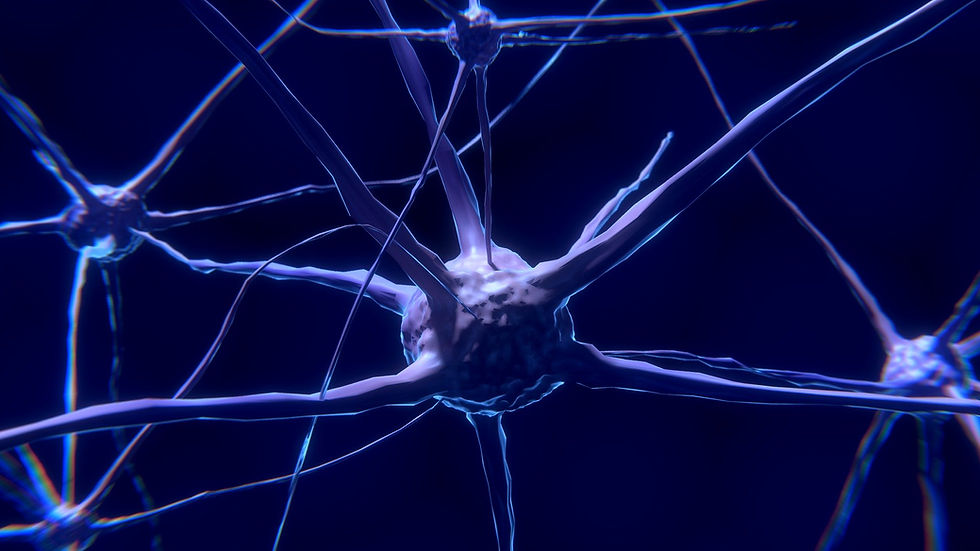Neurons: cells of the Nervous System
- Stem to go

- Jul 11, 2020
- 3 min read
Cells are the basic units of living things. Growth and duplication of cells also leads to the growth of living things. However, the cells of the nervous system, the neurons, don’t undergo duplication. Once a neuron dies, it never exists again.

(image provided by Pixabay, copyright free)
In this article, you are going to learn about the history of studying neurons and the basic structures and functions of them. Continue to read to learn more!
In the late 19th century and early 20th century, Camillo Golgi, an Italian scientist, and Santiago Ramón y Cajal, a Spanish scientist, both studied neurons. They both stained and drew what they saw in the microscope. However, their methods presented completely opposite conclusions.
Camillo Golgi developed the silver staining technique in which the features of neuron tissue could be seen clearly under a microscope. With the use of silver staining technique, Golgi observed and drew the neurons. He advocated the reticular theory- which most people believed at that time -that the nervous system is made up of a continuous single network.
Using Golgi’s method, Cajal came up with a different idea. By experiments and plenty of drawings, what Cajal discovered contradicted the reticular theory. Cajal believed that the nervous system is made up of different individual cells. This was later known as the Neuron Doctrine.
In 1906, Golgi and Cajal both won the Nobel Prize for Physiology or Medicine. Golgi still believed that the Neuron Doctrine would end up being wrong and emphasized so in his speech.
Today in the 21st century, we believe Cajal’s Neuron Doctrine to be right. However, although Golgi was wrong about the Reticular Theory, without his silver staining technique, Cajal wouldn’t be able to develop the Neuron Doctrine. For more about Golgi’s discoveries and achievements, visit this site: https://www.sunsigns.org/famousbirthdays/d/profile/camillo-golgi/
Today Golgi and Cajal are known as the “Two Fathers of Neuroscience”, and their discoveries are studied and discussed many many times…
Neurons are functional units of the Nervous System, and are responsible for sensory information input and motor information output. A neuron is primarily composed of a cell body, dendrites, and an axon. Additionally, the synaptic terminal at the end of a neuron is also important.

Cell body: The cell body is also known as the soma. It contains the organelles like other cell types, and is the center of the neuron. The cell body is responsible for carrying genetic information, maintaining the cell’s structure, and providing energy for activities.
Dendrites: They play an important role in receiving and processing signals. They are the roots that branch out from the cell body that are responsible for sensing the environment. The quantity of dendrites depends on what the neuron’s specific function is.
Axon: The long projection out of the cell body and is responsible for the sending of the information. Many axons are surrounded by a fatty substance called myelin which helps them send information rapidly.
Synaptic terminal: The end of the presynaptic neuron where the messages would be sent to another neuron (the postsynaptic neuron) by the release of chemical messengers known as neurotransmitters.
Despite all having a cell body, an axon, and sets of dendrites, neurons can look different from one another due to their varying functions. Another thing worth noticing is that unlike all the other body cells, neurons do not undergo mitosis, which means they do not duplicate. A neuron is always unique and once it dies, it never exists again.
Neuronal interactions are important for our everyday life, and neurons play an extremely important role during these processes. When you are talking, studying, exercising, or performing any other movements, please think about them —— neurons, the functional units of the nervous system. They define who we are as humans.
Written by: Benetta Wang
References:
“Camillo Golgi Biography, Life, Interesting Facts.” Famous Birthdays By SunSigns.Org, www.sunsigns.org/famousbirthdays/d/profile/camillo-golgi. Accessed 9 July 2020.
Warmflash, David. “Santiago Ramón y Cajal and Camillo Golgi.” Visionlearning, 12 Feb. 2017, www.visionlearning.com/en/library/Inside-Science/58/Santiago-Ram%C3%B3n-y-Cajal-and-Camillo-Golgi/233.
Vandergriendt, Carly. “What Are Neurons?” Healthline, 6 June 2020, www.healthline.com/health/neurons#types.




Comments